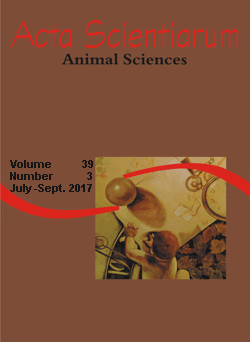<b>Nutritional value of dual-purpose wheat genotypes pastures under grazing by dairy cows
Resumo
In the south of Brazil, one of the major limitations to milk production is the low forage availability during autumn and early winter. The use of dual-purpose wheat genotypes is one alternative to minimize the impact of low forage availability in addition to produce grains. Therefore, this study aimed to evaluate the nutritional value of two dual-purpose wheat genotypes (BRS Tarumã and BRS Umbu). Structural composition and forage nitrogen uptake were evaluated. The nutritional value of the forage was analyzed for mineral matter (MM), organic matter (OM), neutral detergent fiber (NDF), crude protein (CP), total digestible nutrients (TDN), in situ organic matter digestibility (ISOMD) and in situ dry matter digestibility (ISDMD). Differences in NDF (49.03 vs. 46.44%), CP (24.4 vs. 27.4%), ISOMD (83.53 vs. 85.45%), ISDMD (83.59 vs. 86.65%) and TDN (75.37 vs. 78.39) for BRS Umbu and BRS Tarumã genotypes were detected, respectively. The BRS Umbu genotype had a lower leaf blade proportion and forage nitrogen uptake. The dual-purpose wheat genotype BRS Tarumã was superior in nutritive value.
Downloads
DECLARAÇÃO DE ORIGINALIDADE E DIREITOS AUTORAIS
Declaro que o presente artigo é original, não tendo sido submetido à publicação em qualquer outro periódico nacional ou internacional, quer seja em parte ou em sua totalidade.
Os direitos autorais pertencem exclusivamente aos autores. Os direitos de licenciamento utilizados pelo periódico é a licença Creative Commons Attribution 4.0 (CC BY 4.0): são permitidos o compartilhamento (cópia e distribuição do material em qualqer meio ou formato) e adaptação (remix, transformação e criação de material a partir do conteúdo assim licenciado para quaisquer fins, inclusive comerciais.
Recomenda-se a leitura desse link para maiores informações sobre o tema: fornecimento de créditos e referências de forma correta, entre outros detalhes cruciais para uso adequado do material licenciado.








































